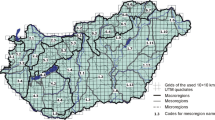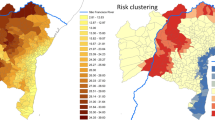Abstract
We modeled the spatial distribution of the most important Chagas disease vectors in Argentina, in order to obtain a predictive mapping method for the probability of presence of the vector species. We analyzed both the binary variable of presence-absence of Chagas disease and the vector species richness in Argentina, in combination with climatic and topographical covariates associated to the region of interest. We used several statistical techniques to produce distribution maps of presence–absence for the different insect species as well as species richness, using a hierarchical Bayesian framework within the context of multivariate geostatistical modeling. Our results show that the inclusion of covariates improves the quality of the fitted models, and that there is spatial interaction between neighboring cells/pixels, so mapping methods used in the past, which assumed spatial independence, are not adequate as they provide unreliable results.




Similar content being viewed by others
References
Adin A, Martínez-Beneito MA, Botella-Rocamora P, Goicoa T, Ugarte MD (2016) Smoothing and high risk areas detection in space-time disease mapping: a comparison of P-splines, autoregressive, and moving average models. DOI, Stochastic Environmental Research and Risk Assessment. doi:10.1007/s00477-016-1269-8
Blangiardo M, Cameletti M, Baio G, Rue H (2013) Spatial and Spatio-temporal models with R-INLA. Spatial and Spatio-temporal Epidemiology 4:33–49
Besag J (1974) Spatial interaction and the statistical analysis of lattice systems. Journal of the Royal Statistical Society B 36:192–236
Besag J, York J, Mollie A (1991) Bayesian image restoration, with two applications in spatial statistics. Annals of the Institute of Statistical Mathematics 43:1–21
Besag J, Green PJ, Higdon DM, Mengersen KL (1995) Bayesian computation and stochastic systems (with discussion). Statistical Science 10:3–66
Besag J, Higdon D (1999) Bayesian analysis of agricultural fieel experiments. Journal of the Royal Statistical Siciety: Serie B 61(4):691–746
Box, G. and Tiao, G. (1973). Bayesian Inference in Statistical Analysis. John Wiley and Sons
Canale DM, Cecere MC, Chuit R, Guoertler RE (2000) Peridomestic distribution of Triatoma garciabesi and Triatoma guasayana in northwest Argentina. Medical and veterinary entomology 14(4):383–390
Clayton D, Kaldor J (1987) Empirical Bayes estimates of age-standardized relative risks for use in disease mapping. Biometrics 43:671–681
Coura JR, Junqueira AC, Fernandes O, Valente SA, Miles MA (2002) Emerging chagas disease in Amazonian Brazil. Trends in parasitology 18(4):171–176
Cressie NAC (1993) Statistics for Spatial Data, Revised edn. Wiley, New York
Cruz-Reyes A, Pickering-López JM (2006) Chagas disease in Mexico: an analysis of geographical distribution during the past 76 years—A review. Mem. Inst. Oswaldo Cruz 101(4):345–354
De la Vega G, Medone P, Ceccarelli S, Rabinovich J, Schilman PE (2015) Geographical distribution, climatic variability and thermo-tolerance of Chagas disease vectors. Ecography 38:1–10
Díaz-Avalos C, Peterson DL, Alvarado E, Ferguson SA, Besag JE (2001) Space-time modelling of lightning-caused ignitions in the Blue Mountains, Oregon. Canadian Journal of Forest Research 31:1579–1593
Díaz-Avalos C (2007) Spatial modeling of habitat preferences of biological species using markov random fields. Journal of Applied Statistics 34(7):807–821
Galvao C, Justi SA (2015) An overview on the ecology of Triatominae (Hemiptera: Reduviidae). Acta Tropica 1521:116–125
Gorla DE (2002) Variables ambientales registradas por sensores remotos como indicadores de la distribución geográfica de Triatoma infestans (Heteroptera: Reduviidae). Ecología austral 12(2):117–127
Gneiting T, Raftery AE (2007) Strictly proper scoring rules, prediction, and estimation. J Am Stat Assoc 102(477):359–378
Gneiting T, Kleiber W, Schlather M (2010) Matérn Cross-Covariance functions for multivariate random fields. J Am Stat Assoc 105(491):1167–1177
Gurgel-Goncalves R, Galvaño C, Costa J, Peterson AT (2012) Geographic distribution of Chagas disease vectors in Brazil based on ecological niche modeling. J Trop Med 2012:1–15
Gurtler RE, Yadon ZE (2015) Eco-bio-social research on community-based approaches for Chagas disease vector control in Latin America. Transactions of The Royal Society of Tropical Medicine and Hygiene 109(2):91–98
Hastings WK (1970) Monte Carlo sampling methods using Markov chains and their applications. Biometrika 57:97–109
Illian JB, Sorbye SH, Rue H (2012) A toolbox for fitting complex spatial point processes models using integreted nested Laplace approximations (INLA). The Annals of Applied Statistics. 6(4):1499–1530
Illian JB, Martino S, Sorbye SH, Gallego-Fernández JB, Zunzunegui M, Esquivias MP, Travis JMJ (2013) Fitting complex ecological point process models with integrated nested Laplace approximation. Methods in Ecology and Evolution 4(4):305–315
Knorr-Held L, Rue H (2002) On block updating in Markov random field models for disease mapping. Scandinavian Journal of Statistics 29(4):597–614
Knorr-Held L, Schrödle B, Rue H.(2009). Posterior and cross-validatory predictive checks: a comparison of MCMC and INLA (2009) In: Tutz G, Kneib T (eds) Statistical modelling and regression structures: Festschrift in honour of Ludwig Fahrmeir. Physica-Verlag, Heidelberg. http://www.r-inla.org/papers
Lin C-H, Wen T-H, Teng H-J, Chang N-T (2014) The spatio-temporal characteristics of potential dengue risk assessed by Aedes aegypti and Aedes albopictus in high-epidemic areas. Stochastic Environmental Research and Risk Assessment. doi:10.1007/s00477-014-0940-1
Lindgren F and Rue H (2013) Bayesian spatial and spatio-temporal modelling with R-inla. J Stat Softw 63(19). doi:10.18637/jss.v063.i19
Lindgren F, Rue H, Lindstrom J (2011) An explicit link between Gaussian fields and Gaussian Markov random fields: The SPDE approach (with discussion). Journal of the Royal Statistical Society, Series B 73(4):423–498
Medone P, Ceccarelli S, Parham PE, Figuera A, Rabinovich JE (2015) The impact of climate change on the geographical distribution of two vectors of Chagas disease: implications for the force of infection. Philosophical Transactions of the Royal Society of London B: Biological Sciences 370:20130560
Nouvellet P, Cucunube ZM, Gourbitre S (2015) Chapter Four-Ecology, Evolution and Control of Chagas Disease: A Century of Neglected Modelling and a Promising Future. Advances in parasitology 87:135–191
Peterson AT, Sánchez-Cordero V, Beard CB, Ramsey JM (2002) Ecologic niche modeling and potential reservoirs for Chagas disease, Mexico. Emerging infectious diseases 8:662–667
Plummer M (2008) Penalized loss functions for Bayesian model Comparation. Biostatistics. 9(3):523–539
Qi Y, Wu J (1996) Effects of changing spatial resolution on the results of landscape pattern analysis using spatial autocorrelation indices. Landcape Ecology 11(1):39–49
R Development Core Team. (2011). R: A language and environment for statistical computing. R Foundation for Statistical Computing. http://www.r-project.org/
R-INLA project, accessed on August 13, 2012. http://www.r-inla.org/home
Rue H, Martino S (2006) Approximate Bayesian inference for hierarchical Gaussian Markov random fields models. Journal of Statistical Planning and Inference. 137:3177–3192
Rue H, Martino S. and Chopin N. (2007). Approximate bayesian inference for latent gaussian models using integrated nested laplace approximations. Statistics Report No. 1, Department of Mathematical Sciences, Norwegian University of Science and Technology, Trondheim, Norway
Rue H, Martino S, Chopin N (2009) Approximate Bayesian Inference for Latent Gaussian Models using Integrated Nested Laplace Approximations (with discussion). Journal of the Royal Statistical Society B. 71:319–392
Schofield CJ, Jannin J, Salvatella R (2006) The future of Chagas disease control. Trends in parasitology 22(12):583–588
Simpson D, Illian J, Lindgren F, Sorbye S.H. and Rue H. (2011). Going off grid: computationally efficient inference for log-Gaussian Cox processes. NTNU Technical Report 10, Trondheim University. http://www.math.ntnu.no/ daniesi/S10-2011
Schmunis GA, Yadon ZE (2010) Chagas disease: A Latin American health problem becoming a world health problema. Acta Tropica 115:14–21
Taylor BM, Diggle P (2014) INLA or MCMC?. A tutorial and comparative evaluation for spatial prediction in log-Gaussian Cox processes. Journal of Statistical Computation and Simulation. 84(10):2266–2284
Tiernery L, Kadane JB (1986) Accurate Approximations for posterior moments and marginal densities. Journal of the American Statistical Association. 81:82–86
Ugarte MD, Ibáñez B, Militino AF (2005) Detection of spatial variation in risk when using CAR models for smoothing relative risks. Stochastic Environmental Research and Risk Assessment 19(1):33–40
World Health Organization (2002). Control of Chagas disease. Second report of the WHO Expert Committee. W.H.O. Tech. Rep. Ser. 905, Geneva, 1-109
Zeledon R, Rabinovich JE (1981) Chagas disease: an ecological appraisal with special emphasis on its insect vectors. Annual review of entomology 26(1):101–133
Acknowledgements
We thank J. E. Rabinovich from Centro de Estudios Parasitologicos y de Vectores of Buenos Aires, Argentina for drawing our attention to this particular application problem and for providing access to the Chagas data base used. Work partially funded by grant MTM2013-43917-P from the Spanish Ministry of Science and Education, grant PAPIIT IN114814 of the Dirección General de Asuntos del Personal Académico of the Universidad Nacional Autónoma de México and Grant CONACYT number 241195.
Author information
Authors and Affiliations
Corresponding author
Appendix
Appendix
See Figs. 5, 6, 7, 8, 9, Tables 4, 5, 6, 7 and 8.
Rights and permissions
About this article
Cite this article
Juan, P., Díaz-Avalos, C., Mejía-Domínguez, N.R. et al. Hierarchical spatial modeling of the presence of Chagas disease insect vectors in Argentina. A comparative approach. Stoch Environ Res Risk Assess 31, 461–479 (2017). https://doi.org/10.1007/s00477-016-1340-5
Published:
Issue Date:
DOI: https://doi.org/10.1007/s00477-016-1340-5









